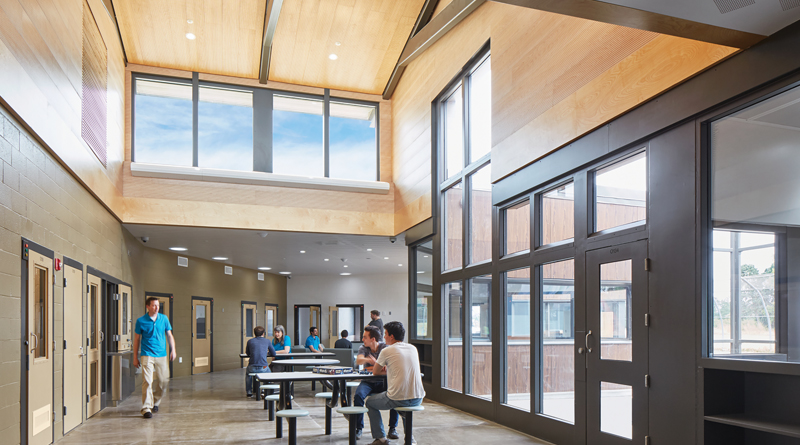The New Model for Remanded Youth: Spaces for Hope, Healing & Transformation
By Darrell Stelling
The number of youth convicted and in custody today has decreased by an estimated 41 percent over the past 20 years, and that’s a good thing. Most agencies agree that youth respond best to corrective intervention in community-based programs while remaining in their family home. When this intervention fails to achieve desired results, community-based programs including housing present a second-tier option. If the individual fails to respond even in these programs, then they may face intervention that is more intensive in a corrections/detention environment. More and more, the planning and design of these new facilities focus on positive outcomes by providing in-custody youth with appropriate housing and program space within a normative environment. The goal is not only to reduce stress, but also to avoid “institutionalizing” youth by dictating decisions and activities, rather than equipping them to make better decisions in the future. The more defined the treatment goals of the youth agency, the more specifically the design will respond to those goals.

Across the country, communities and government agencies are creating and exploring new methods of addressing remanded youth with positive results. Two prime examples are now operational at the Oregon Youth Authority’s (OYA) MacLaren Campus in Woodburn and Los Angeles County’s new Campus Kilpatrick. Each of these models move the culture from custody and control to care and custody to acknowledge society’s need to provide custody of these at-risk youth while developing means to model and communicate care.
Two experts involved in the development of these facilities weigh in about the unique features and the mission of each project. Lori Coppenrath, DLR Group principal and justice+civic planner, worked with OYA in developing its new model for juvenile intervention and care. Andrew Cupples, FAIA, DLR Group principal and justice+civic design leader, led the team in designing L.A. County’s juvenile prototype at Campus Kilpatrick.
MacLaren Campus
In the case of the Oregon Youth Authority, its staff identified a treatment method known as Positive Human Development (PHD). The focus of PHD is to create constructive positive connections and participation: youth to youth, youth to staff, youth to community and staff to community. As the positive relationships grow, youth become more accountable and engage with others based on high expectations. Specific approaches and programs within this model include Cognitive Behavioral Therapy, Collaborative Problem-Solving, Dialectical Behavior Therapy, Effective Practices in Community Supervision and Trauma-Informed Care.
To meet the goals of PHD, the program (developed by Long Beach, Calif.-based Chinn Planning Inc.) and the design of the space works to improve outcomes for youth, reduce future victimization and maximize use of resources. These design elements include:
• Campus layout that supports operational requirements for staff observation of youth
• Appropriate use of materials that contribute to youth safety and treatment success
• Exterior landscape area zoning as a layered approach to transition from private to public areas
• Private enclosed courtyard space allowing youth to connect with nature and the outdoor environment
Normative Design: Exterior and interior design feels “normative” by using materials, furnishings and layout of spaces that communicate a comfortable environment while still providing the appropriate level of safety and security. PHD concepts for the unit designs included individual sleeping rooms with windows, desks and shelves and an interactive art wall for youth expression. Day room and multipurpose areas have expansive pastoral views to alleviate the feeling of being closed in. An exterior courtyard within the secure housing zone allows youth to step outside during free time.
Significant Daylight: Staff safety and success is critical to youth success. In addition to daylighting, the design addresses clear sight lines, with the ability to supervise and manage movements and events safely in every area of this campus. Most importantly, the ability and opportunity to interact one on one with youth in this new and normative environment are creating the desired results for OYA.
Artist-Generated, Youth-Engaged Graphics: Throughout the design process, youth were involved in planning and design efforts. From having a visioning charrette with 15 youth to including a youth intern in all of the design meetings, the input of the youth was included in almost every aspect of the design. The most obvious component of youth involvement is the graphics used to create a sense of identity for these physically identical six buildings. A team of youth worked with designers and an artist to create art that is not only used to decorate the space but also has meaning for the youth housed there.
Check out the article in the March/April issue of Correctional News.

